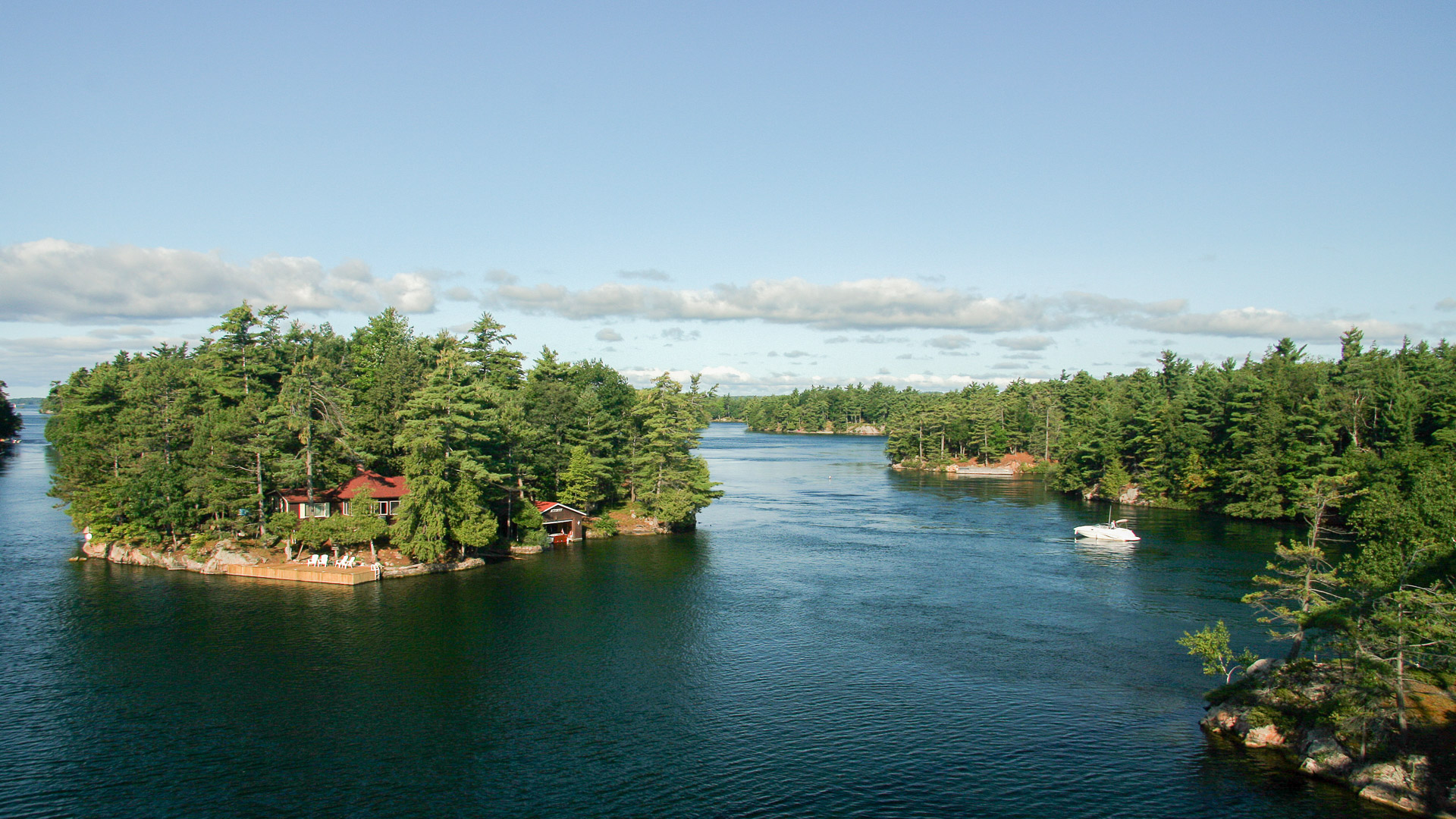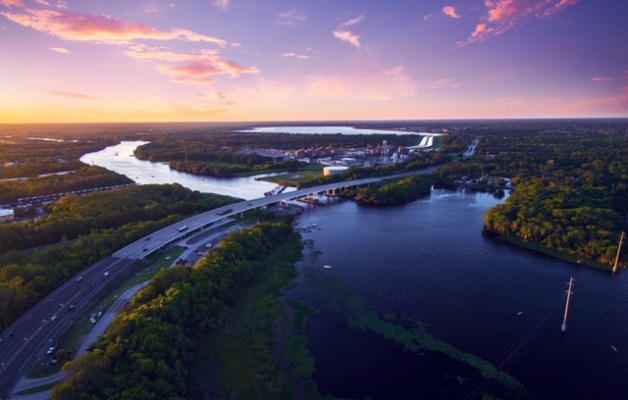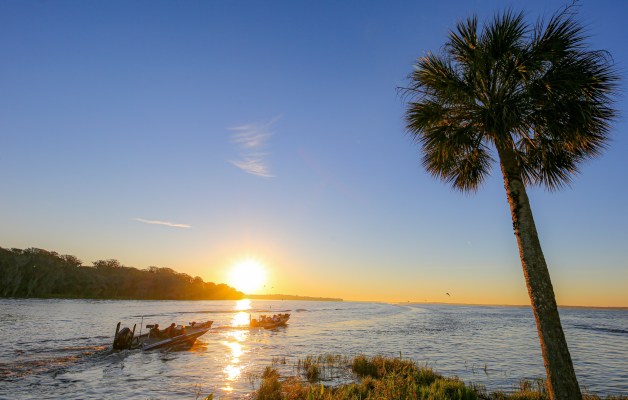
So, we hear a number and immediately think, “Tell me how you got that.” It’s human curiosity and a common inquiry for visitors exploring upstate New York’s visually stunning and numerically impressive region known as the Thousand Islands.
Stretching about 50 miles from the mouth of the St. Lawrence River — between Kingston, Ontario, and Cape Vincent, N.Y. — upriver to Ogdensburg, the Thousand Islands has long held a mystique that truly lives up to the hype. Shared by two nations, this magnificent archipelago fairly ranks on North America’s must-see list.
Sure, some folks will literally count land masses on Google Earth, but we’ll make it simple: The actual number is 1,864. Details matter, of course, but round numbers like a thousand are easier to remember, and they look cool on tourism media.
Essentially the emergent tips of an ancient mountain chain carved by Ice Age glaciers, the islands range in size from over 40 square miles with multiple structures to tiny, uninhabited rock outcroppings. There’s even a couple of legit castles in the mix. (More on this in a moment.)
What qualifies? An official island must have at least 1 square foot of emergent land year-round and support at least one living tree. By this standard, the “Thousand Islands” family includes a lot of glorified rock mounds, but keep your camera handy — there are plenty of sights to see.
Notables
With rugged, rocky complexions adorned by natural greenery, just about every island in this chain boasts photo-worthy appeal. However, several sites consistently attract sightseers on private vessels, as well as the tour boats running out of U.S. and Canadian ports.

Heart Island — A popular shore excursion, Heart is home to the opulent Boldt Castle — the crown jewel of the famous “Millionaire’s Row” founded by former Waldorf Astoria Hotel Group President George C. Boldt. Planned to honor Boldt’s wife, Louise, the six-story, 120-room design included tunnels, a powerhouse, an elaborate children’s playhouse, Italian gardens, a drawbridge and a dovecote.

Construction began in 1900, but when Louise died in 1904, Boldt halted the project and never returned to Heart Island. Following years of decay, the Thousand Islands Bridge Authority purchased the property in 1977, completed the construction and today operates the island’s tourism services.
(Notably, Boldt is credited with introducing the popular salad dressing through his hotel’s restaurant after first tasting it while cruising the namesake region.)
Wolfe Island — With more than 30,000 acres, the largest island entirely in Canada dominates the landscape at the mouth of the St. Lawrence River.
Just Room Enough Island (aka Hub Island) — At 3,300 square feet, this is known as the smallest inhabited island, with a house, a tree, shrubs and a small beach.
Grindstone Island — The fourth-largest island is home to Potters Beach, one of the only naturally occurring sandy beaches in the Thousand Islands.
Dark Island — In 1902, Singer Sewing Machine Co. president Frederick Gilbert Bourne commissioned acclaimed architect Ernest Flagg to create a hunting lodge of pure grandeur. Basing his design on the “Two Towers” lodge from Sir Walter Scott’s novel Woodstock, Flagg’s immaculate creation — Singer Castle — featured granite walls and turrets, a turret dungeon, 28 rooms (several with hidden observation grates), a network of secret passageways and a five-story clock tower overlooking the St. Lawrence River.

Cherry Island — Here, we find the Victorian mansion Casablanca, the former riverside retreat of tobacco and sugar planter Louis Marx. Photographers love the lion and gargoyles guarding the waterfront patio.

Pullman Island — George M. Pullman, whose Pullman Palace Car Co. developed the railway sleeping “Pullman” car, is credited with bringing a little-known island getaway in the St. Lawrence River to national prominence by building the area’s first castle (Castle Rest) on what was originally named Sweet Island. Castle Rest was razed in the 1950s, and a modern residence now stands next to the original stone chimney of the power plant that once provided the estate’s electricity.

Devil’s Oven — The modest, loaf-shaped rocky outcropping attracts swimmers for a two-story plunge from its cliff. Local history also tells of infamous river pirate Bill Johnston, who hid within a Devil’s Oven cave accessible only by water after sinking the Canadian steamer Sir Robert Peel.
Carleton Island — The now-ruined Fort Haldimand was built here in 1779 by the British during the American Revolutionary War. During the War of 1812, the island was captured by three American soldiers and remains part of the United States.

Deer Island — Steeped in mystery, this island is used as a retreat for Yale’s secretive Skull and Bones society.
Longue Vue Island — Located near Boldt Castle, this is the only man-made site in the Thousand Islands.
Ironsides Island — This uninhabited rocky island is home to one of northern New York’s largest great heron rookeries. (listed as a National Natural Landmark, 1967)

Zavikon Islands — With the larger of the two islands completely surrounded by Canadian waters and the smaller encompassed by U.S. waters, the 42-foot wooden bridge linking the Zavikons is said to be the world’s smallest international crossing. The residents on the main island cross the border each time they visit their backyard.

St. Elmo’s Island — Named for the patron saint of sailors, this island bears a large white anchor on its waterside lawn in honor of those lost at sea.
A River Runs Through It
Named for the third-century Roman Catholic deacon martyred in the Christian persecution ordered by Roman Emperor Valerian, the St. Lawrence River traces part of the international boundary between Ontario, Canada, and the U.S., also traversing Quebec. From its Lake Ontario origin, the river actually flows 310 miles northeastward and meets the Atlantic Ocean through the Gulf of St. Lawrence.
The Hydrology — Lake Superior drains into Lake Huron via the St. Mary’s River, with Huron (linked to Lake Michigan via the Straits of Mackinac) sending its water to Lake Erie via the St. Clair and Detroit rivers (passing through Lake St. Clair). With Erie draining into Ontario via the Niagara River, a massive volume of water flows to the Atlantic Ocean through the St. Lawrence River.
When Lake Ontario enters the northeast-flowing St. Lawrence, all that lake current becomes constricted and accelerates over its 744-mile course to the Atlantic Ocean. The swift current, plus water-filtering zebra mussels, yields tremendous clarity. Anglers commonly report looking at smallmouth bass in 20 feet of water.

Vessels Of All Types — Look at the photo galleries from Bassmaster Elite Series events on the St. Lawrence and you’ll see an annual favorite for Bassmaster photographers: a bass boat framed against the hulking form of a commercial ship 20 times its size.

No doubt, along with the multitude of recreational vessels — fishing boats to mega-yachts — the river forms the essential element of the St. Lawrence Seaway. However, not all of the commercial traffic traverses oceanic shipping lanes. Actually, St. Lawrence ships are classified as one of the following.
• Salties — Larger, more robustly designed ships made for transoceanic voyages, these are usually multipurpose vessels which can transport bulk cargo, break bulk cargo and project cargo.
• Lakers — Built for use within the Great Lakes/St. Lawrence system, these vessels carry bulk cargo and have a unique configuration capable of fitting through the navigation locks. Lakers are designed to operate under the weather and freshwater hydrologic conditions in the Great Lakes.
In The Area
While in the Thousand Islands area, check out these sites (pending the U.S./Canada border opening).

Bridges — Thousand Islands International Bridge (Interstate 81/CA 137) between Clayton and Alexandria Bay, N.Y.; Ogdensburg-Prescott International Bridge (State Road 812/CA 16)
Statue Of St. Lawrence — Located on a cliff overlooking the river in Ivy Lea, Ontario, just east of the Thousand Islands International Bridge, the limestone monument erected by the Admirals of the Thousand Islands is visible only from the water.
1000 Islands Tower — The 400-foot tower on Hill Island (Ontario) offers a 360-degree view of the Thousand Islands region. On a clear day, visitors can see up to 40 miles.

Cape Vincent, N.Y. — Punctuating this collection of mainland hamlets and river/Lake Ontario islands, the Tibbetts Point Lighthouse has guided approaching vessels since 1827. Using one of only 70 Fresnel lenses still operating in the U.S., this 69-foot tower is part of the Great Lakes Seaway Trail and holds a spot on the National Register of Historic Places.

Clayton, N.Y. — With much of its downtown district listed on the National Register of Historic Places, this laidback town 15 miles downriver from Cape Vincent is awash with riverside ambiance and relics of years past. Settled in 1822, Clayton was once a major lumber and shipbuilding port, as well as the northern terminus for the N.Y. Central Railroad.
Local favorites include the world-famous Antique Boat Museum, the world’s largest freshwater maritime museum, the 1,000 Islands Museum of Clayton (featuring the Muskie and Duck Decoy halls of fame) and the American Handweaving Museum and Thousand Islands Arts Center.
Alexandria Bay — The Thousand Islands region offers many land-based viewing/photo opportunities, while pleasure boats can easily approach any of the area’s popular sights. That said, nothing compares to the elevated vantage points of the narrated tour boats running out of the resort town known as “The Heart of the Thousand Islands.”
Considering that this section of the St. Lawrence is a recreational boater’s paradise, with a nearly constant parade of water traffic the ride can get a little bumpy. Visitors often find a river cruise aboard a large, multilevel tour boat the ideal sightseeing option with the benefit of historical insight.
From the signature Millionaire’s Row tour to a longer journey including Singer Castle, as well as Boldt, this is the most efficient way to experience the Thousand Islands. Visit Uncle Sam Boat Tours at www.usboattours.com.

Gananoque, Ontario — Known as the “Gateway to the Thousand Islands,” this tidy, welcoming Canadian city west of the International Bridge is a nice stop for cozy bed-and-breakfast stays, regional cuisine and river tour boats.

Kingston, Ontario — The former capital of Ontario is known as the “Limestone City” for the abundant natural bedrock from which much of its original structures were built. Be sure to visit Fort Henry (tours and seasonal military reenactments), McIntosh Castle and Murney Tower — one of several Martello towers built to defend the city from naval invasions. (In 2007, UNESCO’s World Heritage Organization designated the Rideau Canal-Kingston Fortifications [Fort Henry, Fort Frederick] as Ontario’s first World Heritage Site.)


If You Go
Here are some helpful details for Thousand Islands visits.
Ferry — The historic Horne’s Ferry, the region’s only international ferry crossing, runs from Cape Vincent to Wolfe Island. The Wolfe Island Ferry links to Kingston.
Airports — International airports serving the region are Syracuse Hancock (U.S.) and Kingston Norman Rogers Airport (Canada).
Find local details at visit1000islands.com.






